B2B Keyword Research – A 6 Step Process
Alastair Kane Search Marketing, Search Marketing PartnerRead it in 14 minutes
Read it in 14 minutes
Table of contents
B2B keyword research is a fundamental aspect of digital marketing for companies selling to other businesses. The goal is to build a list of terms that will inform an SEO strategy, aimed at driving relevant traffic to a website from search engines.
Once you have a library of keywords, you can use these to inform your content strategy and publish content that will boost your position in search for these terms.
It’s helpful to ask yourself these three questions as you do B2B keyword research:
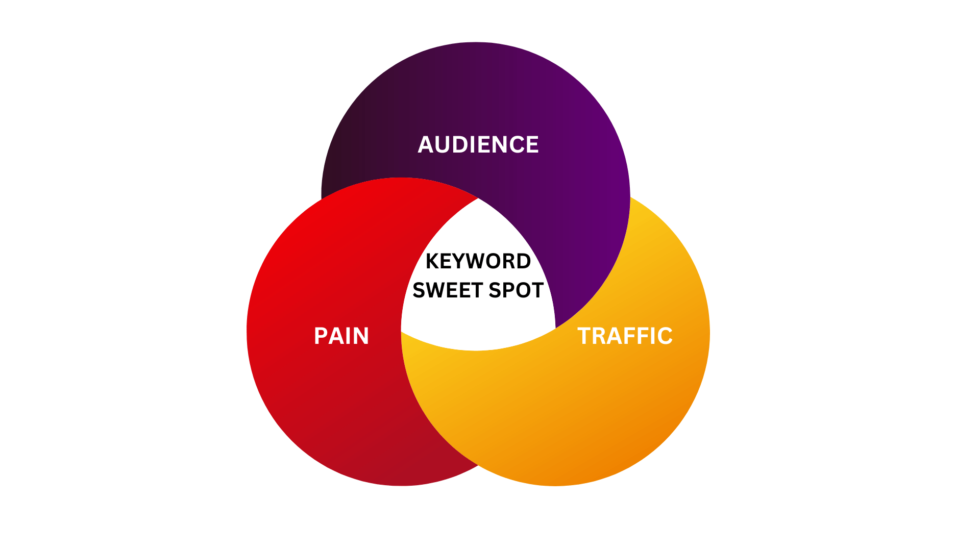
If you can answer ‘yes’ to all three questions, you will have hit the keyword ‘sweet spot’ of audience and pain alignment with good organic traffic generation potential.
B2B and B2C keyword research strategies differ due to differences in target audience and buyer behaviour.
Firstly, B2B marketing targets organisations and the individuals within them who hold purchasing power. This demands a deep understanding of industry-specific terminology, organisational pain points and how your product provides solutions to the specific problems faced by organisational stakeholders.
Furthermore, B2B searchers prioritise finding answers to complex problems or addressing core business objectives. It is essential to create content that provides in-depth insights specifically tailored to meet these requirements.
Content style must also adapt. B2B content emphasises technical depth, reliable information and establishing topical authority in a specific niche that’s relevant to the businesses’ ideal customer profile. This contrasts with broader segments and emotionally driven content found in B2C marketing.
By recognising these key differences, you can refine your keyword research and content strategy to resonate powerfully with your target B2B audience.
Relevant keywords form the backbone of search marketing. Whether you’re doing SEO or PPC, if you’re a B2B company wanting more visibility in the search engines, keyword research is essential.
Here are a few reasons why B2B companies should consider keyword research:
Even if you decide not to run SEO or PPC for your business, doing keyword research is still a valuable exercise in assessing the value of search marketing. It can help you make important decisions regarding where to spend that precious marketing budget.
And unlike other forms of marketing research, keyword research is a cost effective way of getting insights into audience behaviour.
Interested? Then read on to read about my 6 step B2B keyword research process!
In the keyword research methodology outlined below, I’ve suggested some steps you can take to build a library of search terms that will align with the right AUDIENCE, their PAIN, and ultimately generate TRAFFIC.
The process can be summarised in the following six steps:
Here’s a Google Sheet showing an example of applying this process to the seed term business accounting.
The idea of this Google Sheet is to demonstrate the keyword research steps outlined below, so it may help to have it open for reference as you read through each step.
Let’s get started!
Seed keywords are the terms you use to initiate the research process. They tend to be short tail (2 or 3 words) with high search volumes and are broad in topical relevance.
An example of a seed term for a business selling accounting software might be business accounting.
Seed terms are generally too broad (and too competitive) to be commercially valuable to a business. However, the keyword research process I outline below, will help you to find keywords that are more targeted.
Before you get started, it’s important to undertake some research to gather a list of potential seed keywords.
So where should you start?
Customer research should be the foundation of any B2B SEO strategy and will be the starting point for your keyword research process.
Interviewing customers helps you to understand what motivated them to purchase from your business in the first place, and can provide insights that may be missed by solely relying on keyword tools.
Here are examples of questions you can ask your customers to help you draw up your seed keyword list:
Internal teams, such as sales and customer success, could also provide valuable insight into what motivates prospects to become customers. This information will give further ideas for highly relevant seed terms that can be used for your B2B keyword research.
Google Search Console (GSC) is a free tool that provides information needed to ensure there are no technical issues that could be negatively impacting the ability of a website to be visible in organic search.
GSC contains a useful report called Performance which will reveal a sample of queries that people who visit your website have typed into Google.
Head over to Google Search Console and select ‘Performance’ from the left hand menu.
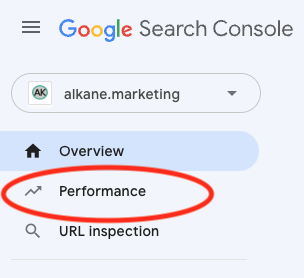
Next select ‘Queries’ to see examples of organic keyword impressions and clicks that users have typed into Google.
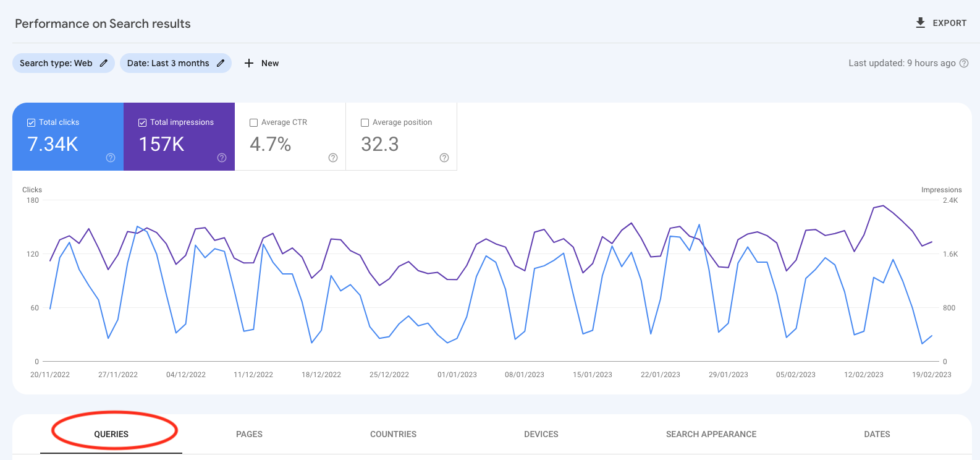
This will provide you with some helpful keyword ideas that your visitors think are relevant, but may not be picked up by SEO tools.
If you have been running Google Ads campaigns, the Search Terms report will provide you with actual keywords visitors have typed in prior to clicking an ad.
This information can be found in the left hand menu of your Google Ads dashboard, under ‘Insights and reports – Search terms’.
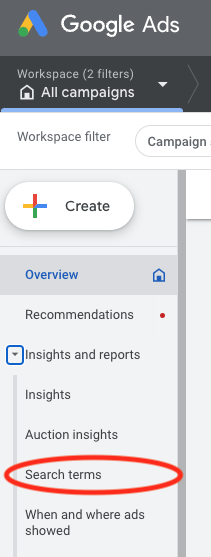
This is another valuable source of keyword data obtained by people that actually visit your website.
In Google Analytics, the Site Search Report will give you the terms your website visitors type into your site search bar. This will provide further information on what your potential customers are searching for when they visit your website
Another way to gather seed terms for your B2B keyword research is to see what your competitors are doing. However, bear in mind they may not be following the right keyword strategy, so be sure to do your due diligence before using their keywords!
Another way to look at the competitor angle is to look at the gaps in their strategy and target keywords that your competitors might not have thought of or started writing content about yet.
Now that you have a list of seed keywords it’s time to pick one and expand it to find related and long tail terms. If you are unsure what seed to start with, pick the one that is closest to what your business sells.
The aim of this step is to expand the seed keyword to find a list of related terms. This results in an extensive library of keywords that you’ll then need to organise, prioritise and use in your content plan.
There are three methods you can use to expand your keyword list.
There are a number of keyword research tools on the market and – each with their own pros and cons but two of the most common are Semrush and Ahrefs.. There are free versions you can use but they do have limitations so it’s worth investing in a paid subscription.
All keyword tools ultimately work the same way – you enter a seed term and it produces a list of related keywords.
Each tool will have its version of keyword difficulty which is a rough measure of how difficult it is to rank in search and they will also provide an approximate monthly search volume.
Whichever tool you decide to use, the process consists of entering your seed term into the tool and exporting to a spreadsheet to create a list (see the first tab in the Google Sheet).
Enter your seed term into Google and make a note of the autocomplete suggestions for more keyword ideas.
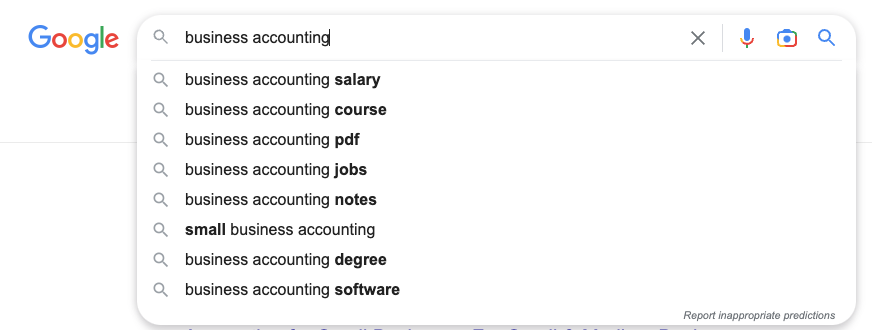
There are tools you can use to help you in this process such as https://keywordtool.io/ and Ahrefs has a feature called ‘Search suggestions’ that will provide a list of autocomplete suggestions for you.
Much easier than having to manually do this in Google!
When you search for something, you’ll often see the ‘People also ask’ feature.
This shows related questions people have searched for, and is another great way of expanding the original seed term. Here’s an example:
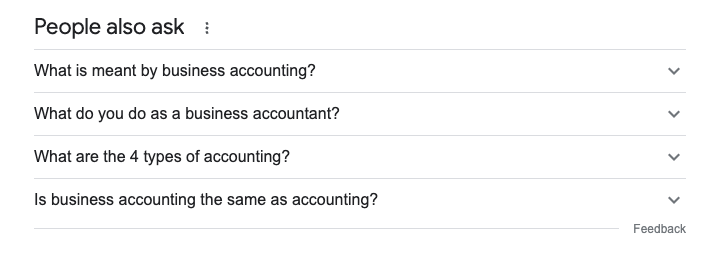
Related searches which are displayed at the bottom of the search engine results page (SERP) works in a similar way and provides more ideas to consider in your research.
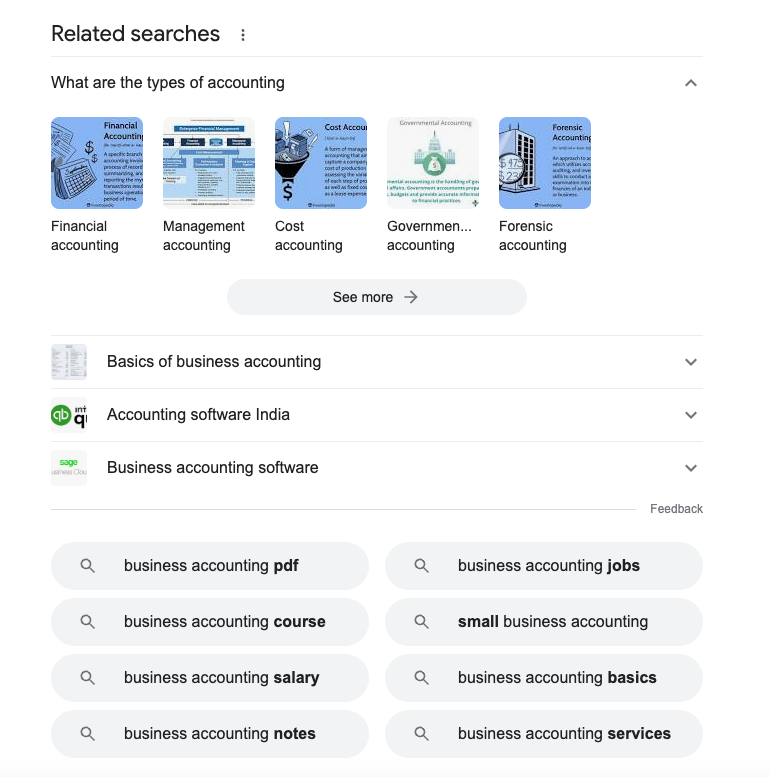
Generative AI tools like ChatGPT can be a powerful way of enhancing your keyword research process. They provide the means to expand your seed keyword, identify user intent and delve into various aspects of a topic. This provides fresh insights that might have been overlooked.
It’s important to note that the quality of the output is reliant on the input you provide, so crafting precise and clear prompts is key to obtaining good results.
However, while AI tools offer support in B2B keyword research, human oversight is essential to ensure that the generated keywords align with the brand’s messaging and objectives.
Keyword data is only helpful when it provides actionable insights on what to focus on for SEO or PPC. Most businesses have limited resources so it’s important to have a system that classifies keywords so that terms which drive the most business value are prioritised.
The system of prioritisation I find works best groups keywords as either Priority, Supplemental or Emerging (see the second tab in the Google Sheet)
Priority keywords
These include terms that are directly related to the product or service the business sells. They can be keywords that have high buying intent or terms further up the sales funnel that reflect prospect pain.
If your business sells accounting software for example, priority keywords for you might be accounting software or how to do small business accounts.
Priority keywords are closely tied to revenue as they connect the business’ product with the challenge the customer is trying to solve.
Supplemental keywords
Supplemental keywords, on the other hand, are relevant to your customer but aren’t directly related to the product or service being sold.
Returning to our previous accounting software example, a supplemental keyword might be how to motivate employees. Although this topic isn’t related to the product, it could be of interest to the CEO of the business, a potential customer of business accounting software.
Supplemental keywords are great for generating brand awareness amongst target prospects that may not be currently in-market for your solution.
Emerging keywords
Emerging keywords reflect future trends. They are likely to have low search volume but have the potential to become more popular (and competitive) over time. In our accounting software business example, an emerging keyword could be ai accounting software.
Being visible in search for emerging keywords shows that the business is a thought leader in its space, which generates trust with your audience.
I would recommend a mix of 75% priority, 20% supplemental and 5% emerging to ensure there is ample content to address the audience’s pain (priority) , reach people that may not be currently in-market (supplemental), and cover new trends in the industry (emerging).
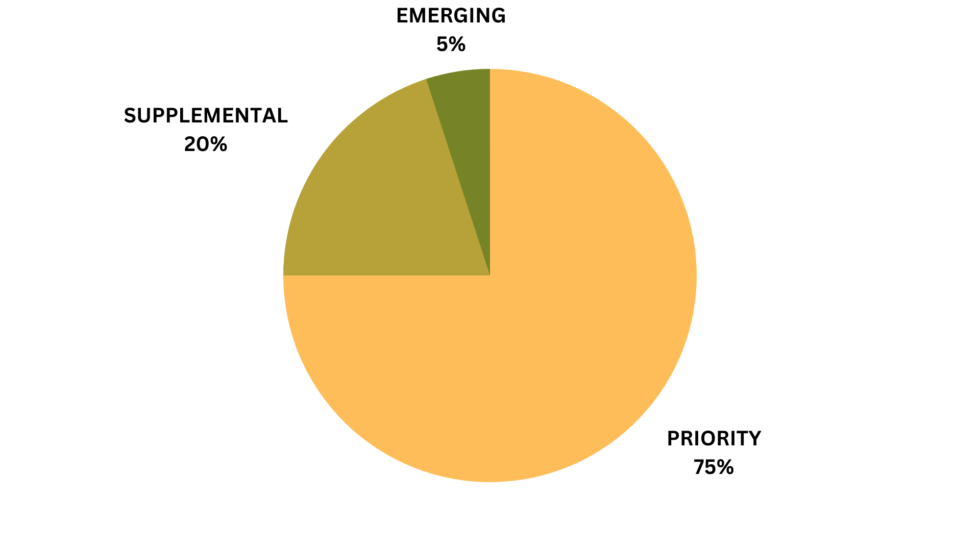
Search intent (or user intent) is the goal the searcher has in mind when they type a keyword into Google. It’s a very important ranking signal, and can help you further prioritise and organise keywords.
For the sake of simplicity, organise keywords into two broad search intent categories that reflect whether the searcher is looking for information prior to purchase, or is ready to buy.
The search intent will determine the type of content needed to rank for the keyword. Blog posts, ebooks and reports and video are examples of content formats that align well with informational terms, whereas product landing pages are suitable for buyer keywords.
Categorise each keyword in your list as having informational or buyer intent, along with an appropriate content format you can use to answer the query.
See the third tab in the Google Sheet.
Quick wins are high impact, but require relatively low effort!
To find terms that are potential quick wins for driving organic visibility, you’ll need to identify keywords that are relevant, have good search volume, and a low difficulty score.
If you have been using Google Sheets to do your keyword research, applying some conditional formatting to the search volume and difficulty score columns will provide an easy way to visually identify quick win terms.
I like to use colour coding according to how good the opportunity is.
For example:
| Colour | Opportunity | Keyword Metrics | Effort Needed to Rank |
| Green | Good | High volume/low difficulty | Low |
| Amber | Medium | Medium volume/medium difficulty | Medium |
| Red | Poor | Low volume/high difficulty | High |
This will enable you to easily spot quick wins (two greens) from your list of keywords, as you can see in the fourth tab of the Google Sheet.
Keyword clustering is a strategic approach involving organising related search terms into focused groups. This allows content marketing strategies to align precisely with audience interests by addressing specific subtopics within a broader subject area.
For instance, within the overarching topic of business accounting, keyword clusters could include how to do small business accounting, the role of financial accounting in business, and AI for business accounting. This approach yields several benefits. It enables the creation of interconnected website pages, each tackling distinct aspects of the main topic. This structure enhances both user experience and demonstrates topical authority to search engines.
Search engines prioritise sites demonstrating subject matter expertise – think Google’s E.E.A.T (Experience, Expertise, Authoritativeness, and Trustworthiness) guidelines. As a result, websites that implement keyword clustering and develop targeted content around those clusters often see improved search engine rankings. This increased visibility translates to greater organic traffic and a higher likelihood of engagement with the intended audience.
See the fifth tab of the Google Sheet.
As with any type of data, B2B keyword research is only useful when organised in a way that makes sense.
Following this 6-step process when conducting your keyword research will help you define your search strategy in the most effective and efficient way, and will ensure you’re prioritising the keywords that matter most to your customers — and your business.
Although your greatest area of focus will be priority keywords, supplemental and emerging keywords will help ensure you’re catering to your wider audience (even if they’re not ready to buy) and will help you future proof your content strategy.
As you go through the process, remember that keywords should always be viewed through a customer-centric filter, to ensure your search strategy is reaching the right audience.
If you have any questions or would like to discuss your search strategy, please get in touch for a consultation.
Sign up to receive B2B Search Marketing Insights direct to your inbox
Book a call to discuss your business' search marketing needs
Book a call